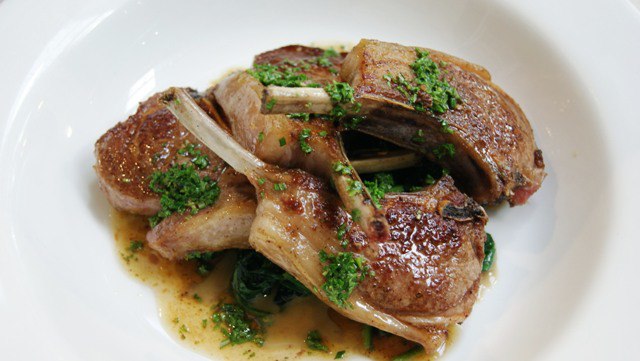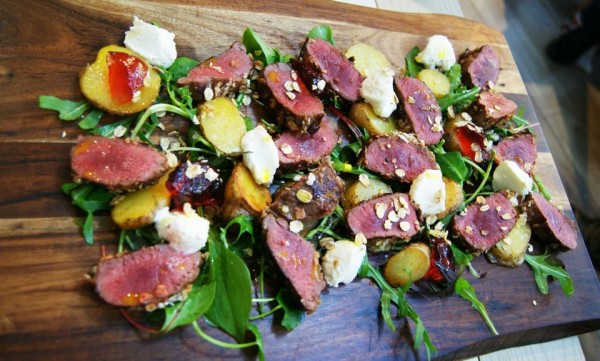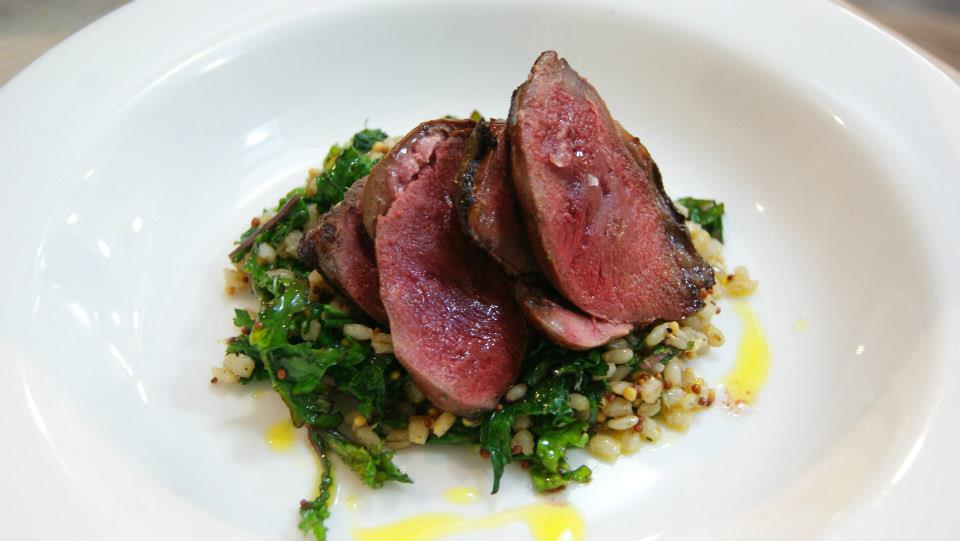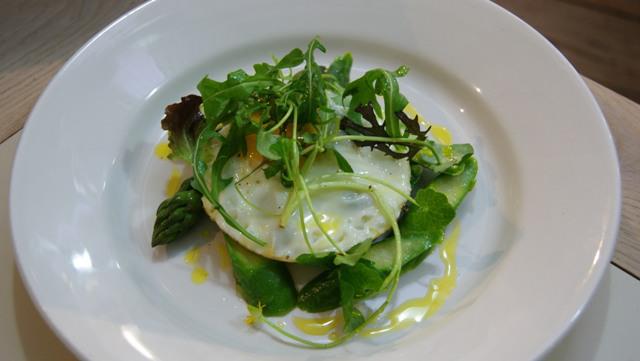Hell dear reader,
A couple of weeks ago I spent a very enjoyable couple of hours on a Friday evening at Hopetoun Farm Shop at a special masterclass by award winning chef Neil Forbes. The shop had challenged Neil to create as many different dishes as he could in two hours using Spring seasonal Scottish produce.
Be warned though – due to the nature of the challenge, this is a very long article – my longest ever blog post – enjoy it at your leisure…
Hopetoun Farm Shop specialises in produce from the 6,500 acre Hopetoun Estate, which lies on the banks of the Forth just outside Edinburgh and is probably the finest stately home in Scotland.

The farm shop has brought together carefully selected award-winning Scottish produce to complement their own Hopetoun product range and has an in-store butchers, bakers, delicatessen and greengrocers. Although they have only been trading for two years, their ethos of quality, sustainability and provenance has already won them various prestigious awards, including a “rural Oscar” from Countryside Alliance, 5 stars from VisitScotland and they have been crowned best new farm shop in the UK by FARMA (the National Farmers’ Retail and Markets Association).
Their aim is to source over 80% of their product range from within 50 miles, something I feel we should all aspire to.
So what of our chef of the evening, Neil Forbes? He has his own list of accolades, most notably being crowned Scottish chef of the year in 2011. Neil has worked with various Michelin-starred chefs and has been head chef at some of the finest restaurants in Edinburgh. He is currently chef-director at Café St Honoré in Edinburgh – that’s Neil on the right.

This French brasserie-style restaurant specialises in serving fantastic, locally sourced Scottish ingredients. Neil works closely with his suppliers to ensure sustainable produce of the highest provenance and taste. He has achieved 3-star champion status for the restaurant from the SRA (Sustainable Restaurants Association) for his Slow Food philosophy and has also recently been awarded the SRA national award for “Society”.
.
So, now you know about the where and the who, on to the event itself!
We are greeted warmly as we walk in the door of Hopetoun Farm Shop and are offered Cairn O’ Mohr Scottish fruit wine. I choose the elderflower, which is slightly sweet but nicely tangy on the tongue. We have time to look around the shop, which is a treasure trove of beautiful Scottish produce. I instantly spot my favourite Scottish beer, Roisin, which is a blond ale flavoured with Tayberries – it is surprisingly difficult to get hold off, so I am already in love with this place! On our seats are a cute card for Neil’s restaurant and a couple of recipe sheets with full details on two of the dishes Neil will be demonstrating this evening. This is a nice touch for those who might want to faithfully replicate Neil’s recipes but might not remember all the fine details, with so much being covered during the evening’s masterclass.
Neil begins by explaining a bit about his ethos of using predominantly local Scottish produce and that his buzz word in life is sustainability. Many of the herbs used in his restaurant are grown in the courtyard just outside the back door. A man after my own heart!
.
Then begins the gradual ensnarement of our senses!
Neil starts with my favourite meat, lamb. The Spring lamb chops come directly from the Hopetoun Estate – you can’t really get better food mileage than that! They are a beautiful colour and with just the right amount of fat to be tasty without being greasy. Neil seasons them lightly with salt & pepper, mentioning that he believes food should be seasoned before, during and after cooking. He adds a little cold-pressed rapeseed oil to his pan; rapeseed oil is his oil of choice as it has a higher flash point than olive oil, so doesn’t burn and it is also locally produced in East Lothian, just outside Edinburgh. Neil then fries the lamb over a medium heat, telling us to never fry over a hot heat as this toughens the outside. He adds a few knobs of butter partway through cooking, adding to the sizzling sounds, to give a good golden colour and nutty flavour and next adds some rosemary. The wonderful aroma of lamb and nutty butter is making my nose twitch in appreciation and I feel that relaxed sensation that I only ever feel around the warming scents of good food. Neil switches off the heat and moves the meat to stand at the edge of the pan to rest, explaining that resting in the pan allows the juices to drain into the pan to be used for a sauce or to cook a garnish. Meanwhile he wilts down a mix of torn spinach and wild garlic leaves. Neil’s garnish of choice here is curly parsley, which I usually hate due to the rough texture of the curly edges and I think many fine dishes are ruined by scattering them with raw handfuls of this evil herb. However, Neil chops it finely, tosses it in the remaining cooking liquid and it instantly softens. I have been won over to his way of parsley-eating! This is the first recipe on our handouts and boy does it look and smell divine – I want to jump straight in to tasting that beautiful lamb!
 Hopetoun lamb cutlets on a bed of wilted spinach and wild garlic, with parsley garnish
Hopetoun lamb cutlets on a bed of wilted spinach and wild garlic, with parsley garnish
.
Next up is chicken, also sourced directly from the Hopetoun estate. Neil cuts this into large chunks and fries in rapeseed oil and butter, with shallots and herbs, then adds cream and Arran mustard. He spends a little time at this point extolling the virtues of Arran mustard, telling us it is better than any other mustard he has had, even the elite French mustards. He is again impressing upon us all the quality of Scottish produce and how it can hold its own with any produce anywhere.
 Hopetoun chicken, with a creamy shallot and Arran mustard sauce
Hopetoun chicken, with a creamy shallot and Arran mustard sauce
At this point I am starting to salivate and thankfully there is enough chicken for everyone to get a taster. It is creamy and delicious and as for that Arran mustard, it is delicate and fruity but still with that punch of heat. My taste buds are tingling and I am thinking that this dish is one-pot cooking at its best!
.
Next to come is Ayrshire bacon, which Neil fries off with chopped wild garlic and capers. He points out that there is very little liquid and no white stuff coming out of the bacon, explaining that good meat should release very little of itself into the pan. He plates the bacon and tops it with soft boiled eggs, then salad leaves, simply tossed in a little oil with salt and pepper, and scatters the plate with walnuts. I think this would make for a simple but tasty supper dish.
 Warm salad of Ayrshire bacon and wild garlic
Warm salad of Ayrshire bacon and wild garlic
.
Staying with Scottish pig, Neil now selects a beautiful pork fillet. It seems almost sacrilegious to chop up such a delicious looking cut of meat but in seconds it is sliced, seasoned and sizzling in a pan with a dash of rapeseed oil (notice any pattern here yet?). The complementing flavours in this dish are shallots, mushrooms, capers and sage.
 Scottish pork with mushrooms, shallots, capers and sage
Scottish pork with mushrooms, shallots, capers and sage
.
Neil now brings it back to the local estate with a loin of Hopetoun venison. Their Roe deer venison is in season right now and the Hopetoun butcher Derek is on-hand later to talk us through the excellent variety of cuts he provides. This is the other recipe sheet we were given at the start. It is to be served with sauté potatoes, which Neil fries with thyme and garlic. He seasons the whole loin of venison, then fries it gently in rapeseed oil until golden all over, then adds butter and bastes it for a further few minutes until just cooked. He then rests it and rolls it in Scottish oats. I hate raw oats as I find them floury and cloying but he then rolls the loin in the pan juices, which soften the oats and make them look golden and tasty. Next he slices the venison and arranges it on a wooden serving board with the sautéed potatoes and garnishes with redcurrant jelly, Scottish Crowdie cheese, salad leaves and toasted oats. It is such a pretty and impressive looking dish, for something which took all of 15 minutes to make, and we all burst into applause and start talking about dinner parties of successional sharing platters. I suspect Neil was amused by how impressed we were with this, after all the cooking is not much different to what he has already shown us, he has just presented it differently. However, I say again… Doesn’t it look amazing?!?
 Loin of Hopetoun venison with sauté potatoes, Crowdie and redcurrant jelly
Loin of Hopetoun venison with sauté potatoes, Crowdie and redcurrant jelly
.
Next is another product particularly associated with Scotland, smoked salmon. This time Neil starts with the accompaniment; he fries leeks and bacon in butter and then adds cream, thyme and seasoning. Next he slices the smoked salmon, fries it in hot oil for about 30 seconds and adds a squeeze of lemon juice.
Hold that pose chef!
 Seared Scottish smoked salmon on a bed of creamed leeks and bacon
Seared Scottish smoked salmon on a bed of creamed leeks and bacon
.
Neil demonstrates pigeon next, again from right here on the Hopetoun estate. He expertly removes the pigeon breasts, telling us with pride that at his restaurant meat is always bought as whole carcasses, so he can use as much of the animal as possible and he makes a point of training younger chefs in butchery skills. When I enquire as to how the home cook can best acquire butchery skills, he advises us to just have a go – buy whole carcasses and give it a go, as it is all quite straightforward and we shouldn’t be nervous or scared of trying, that one animal is much like another and one bird much like another. Neil sears the pigeon breasts briefly on each side and leaves to rest. He fries some chopped kale, stirs in pre-cooked barley and adds a touch of Arran mustard. He mentions in passing that this kale & barley base makes a great cheap and healthy supper dish with a poached egg served on top. This is what I really adore about chef masterclasses – those little titbits of extra information that just happen to pop into their head as they cook. Neil slices the pigeon and serves it on the bed of kale & barley. The pigeon looks far too rare for my liking but when I taste it later it is melt-in-the mouth delicious and I would class it the best taste of the evening.
 Hopetoun pigeon breasts on a bed of kale and barley with Arran mustard
Hopetoun pigeon breasts on a bed of kale and barley with Arran mustard
.
The main ingredient in the next dish is the first key product which Neil has sourced outside Scotland. It is new season asparagus, which he had to source from England as Scotland is always a few weeks behind England in the growing calendar and he wants to show us what we should be looking out for in a few weeks time. He peels the base and discards only the very end, then slices in half and boils gently in salted water for just a few minutes. Whilst it is cooking he fries an organic egg and remarks that it is definitely worth seeking out organic eggs for the exquisite taste and sheer vibrancy of yolk colour. He plates up the asparagus, then the fried egg and tops with seasonal salad leaves, pointing out with delight that they include a primrose flower. I smile remembering that just a couple of weeks ago I wrote a whole blog post about pretty primroses and another on how I’d used them to decorate my spring pavlova.
I’ve never been a great fan of asparagus but when I taste this later it is delicious and is a revelation of flavour. I realise that I have probably only ever eaten supermarket asparagus before and reaffirm to myself my New Year’s resolution to try to be more in touch with the seasons.
 New season asparagus, with fried organic egg and seasonal leaves
New season asparagus, with fried organic egg and seasonal leaves
.
The final dish of the evening is dessert and Neil shows us the whopping great strawberries he’s been given. He’s not sure of their exact provenance but they were bought at ridiculous o’clock that morning at the fruit market in Glasgow. He warms them gently for a few minutes over a medium heat, telling us this is the best way to serve strawberries as it enhances the flavour so much. When we taste them later, everyone remarks that they will definitely be heating their strawberries from now on! He finishes with a few drops of fresh lemon juice and serves simply with creme fraiche and meringues, both sourced from the Hopetoun Farm shop.
 Warmed strawberries with creme fraiche and meringues
Warmed strawberries with creme fraiche and meringues
.
The pattern that has emerged from the evening is how to cook tasty food, fast. Slice the meat into bite-sized chunks, season, fry in a little oil over a medium heat, season, add butter, add any other ingredients you desire, add herbs (ALWAYS add herbs, as Neil would say), season and serve.
Simple.
.
Neil had been challenged to make as many dishes as possible in two hours using Scottish produce from the Spring season larder.
I’d say he rose to the challenge with resounding success, creating nine, yes NINE, dishes in two hours whilst also talking and educating us the whole time. The dishes were all simple but delicious and can be created in very little time – we will all now be able to rustle something together at home, no matter how busy our lives. Well done & thank you Neil!
.
The best message from the evening is one I already felt strongly about – selection of product…
Select good quality, local and in-season ingredients for the best in taste and sustainability.
The tastiest food of the evening has been very local, from the Hopetoun estate itself. This has been complemented mostly by ingredients from a little further afield but still in Scotland. Only when absolutely impossible to source something locally has Neil ventured further afield in produce gathering, for example the asparagus is from England as he wanted to demonstrate a fantastic ingredient that will be in-season in Scotland very soon and for only a short while. The lemon, admittedly, is from the Amalfi Coast but lemons are difficult to grow in Scotland, whilst this part of Italy is famed for them. I believe if you do have to buy non-local products, then buy only those which are in some way special or magical to their own locale.
Speaking of special, do check out Hopetoun Farm Shop for their fabulous Scottish produce. If you want a magical couple of hours of foodie entertainment, check out Neil’s other masterclasses which are regularly listed on his restaurant’s website, Café St Honoré.
Happy eating!
Vohn
x
…
P.S. Special mention must go to Camille Craig of Hopetoun who took all the photographs during the event and kindly allowed me to use them. I did have my camera with me but was enjoying the masterclass & nibbling too much to even think about getting it out of my bag! Thanks Camille.
…
P.P.S. All views and opinions in this post are my own. I paid for my ticket for this event and was not asked to write about it.

Oh that looks like so much fun! The food looks INCREDIBLE!!!
It was fab, thanks Brandi! 🙂
Wonderful! Thank you so much for sharing the wonderful dishes this chef has created!
My pleasure Kecia & thanks so much for popping by & leaving a comment! 🙂
Wow – what an amazing event!
It was Kate – I can’t wait for the next one! 🙂
Vohn, what a fabulous experience it was and it looked like they were very welcoming and approachable! 🙂 That’s great that they use as much of the animal as possible too!
It was fab, thanks Lorraine. I was so impressed to have experienced so many dishes in just two hours. Vohn x